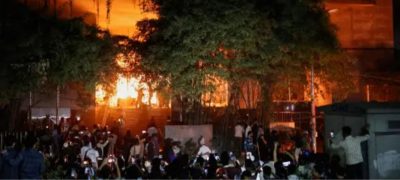The seismic upheaval experienced in central Japan on Monday sent shockwaves throughout the nation, prompting immediate orders for coastal evacuations and setting off a cascade of disruptions across the affected areas. This powerful earthquake, registering a preliminary magnitude of 7.6, wrought havoc with a swift and formidable force that rippled across multiple regions.
The tremors unleashed by this seismic event precipitated a series of consequential effects, notably triggering widespread power outages that plunged thousands of households into darkness across Ishikawa and Toyama prefectures. Simultaneously, transportation services were gravely hampered as the quake struck, derailing train operations, and disrupting high-speed rail services that crisscross the region.
https://twitter.com/spectatorindex/status/1741726428838944775
Read more:Deadly Earth Quake Rocks Northwest China: 100+ Dead, 400 Injured
The subsequent alarms sounded were akin to a jolt, warning of possible impending tsunamis that loomed along the Sea of Japan coast. These warnings, issued for Ishikawa, Niigata, and Toyama, evoked memories of the catastrophic 2011 earthquake and tsunami, sounding the clarion call for evacuation measures to brace for waves that threatened to surpass three meters in height.
Prime Minister Fumio Kishida, in a somber address to the nation, urged unyielding vigilance, emphasizing the looming aftershocks and the criticality of swift evacuation from coastal regions susceptible to the ravages of a potential tsunami. As the dire situation unfolded, NHK, the public broadcaster, relayed urgent alerts instructing specific coastal residents to immediately seek refuge away from the impending danger zones.
Structural integrity buckled under the force of the quake, evident in images of collapsed buildings in Suzu and distressed inhabitants seeking shelter in Kanazawa. The temblor’s far-reaching impact also reverberated in Tokyo, where buildings swayed, serving as a stark reminder of the vulnerability to seismic disturbances even in the nation’s capital.
While nuclear power plants along the coast reported no deviations from the norm, the threat was palpable enough to prompt pre-emptive evacuation procedures at select facilities. Additionally, telecommunications services in affected areas bore the brunt of the quake’s fury, facing disruptions and disconnections.
This seismic catastrophe occurred against the backdrop of a public holiday, disrupting the age-old tradition of temple visits heralding the New Year. Residents, bearing the weight of past devastating earthquakes, sought refuge in schools and other secure facilities, displaying an abundance of caution and a palpable sense of preparedness in the face of imminent danger.
The recent seismic upheaval cast an ominous shadow, echoing the memories of past calamitous earthquakes, thus underlining the pressing need for unwavering preparedness and vigilance during natural disasters. As residents grappled with the aftermath and assessed the extent of the devastation caused by this impactful quake, the echoes of its reverberations lingered as a stark reminder of the precariousness of life in earthquake-prone regions.









